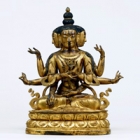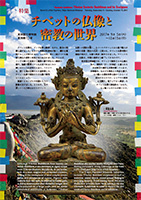Asian Gallery (Toyokan) Room 12
September 5, 2017 (Tue) - October 15, 2017 (Sun)
Although Tibetan Buddhism drew heavily on Indian Buddhism, it also developed in highly unique ways. Tibetan Esoteric Buddhism, in particular, took on a more magical and ceremonial character, leading to the development of more complex artistic forms and pantheons of deities. Figures with multiple faces and arms, as inspired by Indian gods, as well as skeletons and other distinctive images were incorporated on a large scale, and no doubt astonished multitudes of believers. Tibetan Buddhism also reached nearby Mongolia and China, finding particularly strong followings in the Yuan (1271–1368) and Qing (1636–1912) dynasties.
The Tokyo National Museum collection includes Tibetan Buddhist sculptures as well as numerous related objects created around Beijing in the Qing dynasty. From among these, the most distinctive artworks have been selected for this Thematic Exhibition in order to explore the rich world of Tibetan Buddhism and its influences.


